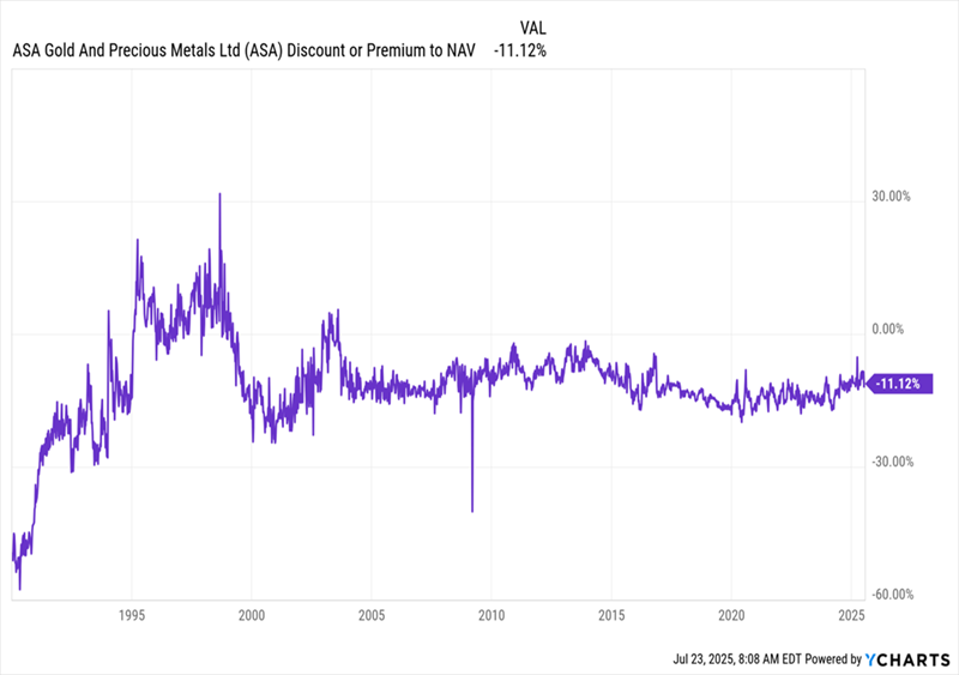Today we’re going to talk about a unique gold fund that’s soared 69.4% so far this year—but despite that huge run, it’s still not a buy.
That said, there is a route to a buy here that I think will surprise you.
So what’s the name of this high-flyer? ASA Gold and Precious Metals Ltd. (ASA). It doesn’t exactly roll off the tongue, and the fund itself isn’t very well-known.
The details: ASA has a bit more than $600 million in assets under management, making it small compared to most ETFs, CEFs’ more popular cousins. As you can likely tell from the name, ASA focuses on gold and other precious metals. Gold itself makes up 72.5% of the portfolio, a collection of mining stocks chip in another 24.8%, and silver comprises a smaller 2% slice.
Here’s the first number that will likely stop you in your tracks: ASA’s dividend yield is 0.2%. That, admittedly, doesn’t get us too excited, especially with all CEFs yielding 8.5% on average, according to data tracked by my CEF Insider service. I would agree that this is a good reason to avoid ASA—but there’s more to the story here.
How This Gold Fund Stacks Up In 2025
Let’s move on to value: As I write this, ASA has an 11% discount to net asset value (NAV). That’s another way of saying that it trades for less than what its portfolio is worth. The fact that the average CEF has just a 4% discount really drives the point home here. However, if we look at ASA’s history, we see something interesting.
ASA has had roughly an 11% discount to NAV for nearly 25 years, with its market price being much lower in the early 1990s and much higher in the late ’90s, due to that decade’s unusual market dynamics. (In the early 1990s, gold lost favor, causing the fund to lose market demand. Then in the late-’90s, the stock-market bubble drove everything higher, including ASA.)
So, is ASA undervalued? Sure. But it always is. So if you buy ASA today for a “bargain,” you should probably expect to sell it for a bargain in the future, too. Okay, so the discount isn’t a good reason to buy ASA. Is its performance? Well, let’s look at that.
ASA is up 69.4% in 2025, and the reason is obvious: The fund is focused on gold, and since gold has soared in 2025, so too has ASA. That’s also why its dividends are so paltry: Gold doesn’t yield anything, so most of ASA’s portfolio yields nothing, as well.
Since CEF investors look for yields, we should expect ASA’s discount to stick around for a long time. But that hardly matters if you’re earning 69.4% profits in a bit over half a year, right? True. But one problem with ASA is that it tends to fall hard after a run-up.
Let’s See How This Gold Fund Performed During Gold’s Last Run Up
Early 2016 was a great time for gold—even better than early 2025, in fact. ASA soared 119% in the first seven months of that year, when gold investments were soaring.
However, after such a big gain, ASA (in purple below) was in the red for the following three years!
Here we see the real risks of buying ASA: If you get to the fund too late, you could find yourself in the red for years afterward, even when gold itself—represented by the SPDR Gold Shares ETF (GLD) in orange above—is doing much better. So if gold has just had a run-up, expect ASA to be set to take a run down.
That’s not the only mark against ASA. Clearly, in the short term, the fund can outrun gold itself, thanks to its higher-risk portfolio. But that also means the fund’s long-term performance is going to be much worse. History has borne that out: Take a look at this chart of ASA’s NAV return (a better measure of management’s skill than market price), verses GLD:
The strategy with ASA, then, is to always bear in mind that the fund can deliver profits to short-term traders—but it’ll weigh down investors who buy for the long haul.
So, with that in mind, here’s the best way to invest in this one—if you choose to at all:
- When gold has done poorly in the recent past, and ASA’s recent total NAV returns (or the total return of its underlying portfolio, including the scant few dividends it generates) are weak, buy.
- When gold has a short-term spike, hold ASA and compound the returns from gold, while riding market demand for gold miners, precious metals and precious-metal funds.
- When gold prices plateau after a recent run-up, sell ASA.
Where are we in this cycle? This chart makes that clear.
Gold has been plateauing since around March, but ASA keeps soaring. That makes it a sell at this point in the cycle. But if you’re looking to invest in gold down the road, you’re best to wait for the metal to sell off. That’s when ASA could shine again—at least for a short time.
Michael Foster is the Lead Research Analyst for Contrarian Outlook. For more great income ideas, click here for our latest report “Indestructible Income: 5 Bargain Funds with Steady 10% Dividends.”
Disclosure: none

